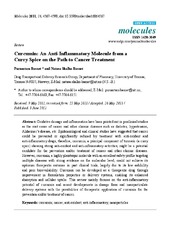Artikler, rapporter og annet (farmasi): Nye registreringer
Viser treff 381-394 av 394
-
Curcumin: An Anti-Inflammatory Molecule from a Curry Spice on the Path to Cancer Treatment
(Journal article; Tidsskriftartikkel; Peer reviewed, 2011)Oxidative damage and inflammation have been pointed out in preclinical studies as the root cause of cancer and other chronic diseases such as diabetes, hypertension, Alzheimer’s disease, etc. Epidemiological and clinical studies have suggested that cancer could be prevented or significantly reduced by treatment with anti-oxidant and anti-inflammatory drugs, therefore, curcumin, a principal component ... -
Retrospective evidence for a biological cost of vancomycin resistance determinants in the absence of glycopeptide selective pressures
(Journal article; Tidsskriftartikkel; Peer reviewed, 2011)To estimate the relative fitness differences between glycopeptide-resistant Enterococcus faecium (GREF) and glycopeptide-susceptible E. faecium (GSEF) from yearly surveillance data on the occurrence of GREF in Danish poultry farm environments. A population genetic model was adapted to retrospectively estimate the biological fitness cost of acquired resistance. Maximization of a likelihood function ... -
Uptake and organ distribution of feed introduced plasmid DNA in growing or pregnant rats
(Journal article; Tidsskriftartikkel; Peer reviewed, 2011) -
Sonosensitive dioleoylphosphatidylethanolamine-containing liposomes with prolonged blood circulation time of doxorubicin
(Journal article; Tidsskriftartikkel; Peer reviewed, 2011)Ultrasound sensitive (sonosensitive liposomes) are drug delivery systems designed for releasing their drug load upon exposure to ultrasound (US). Inclusion of dioleoylphosphatidylethanolamine (DOPE) in liposome membranes was previously shown to induce sonosensitivity. For efficient US mediated drug delivery to solid tumours, a long blood circulation time of the liposomal drug providing high tumour ... -
Characterization of the Ion Exchange Reaction Between Propranolol-H+ or K+ with Amberlite IRP 69 Resin by Both, Isothermal Titration Calorimetry and (Flame) Photometric Equilibrium Analysis
(Journal article; Tidsskriftartikkel; Peer reviewed, 2009) -
The role of pharmacoepidemiological studies in the market withdrawal of carisoprodol (Somadril®) in Europe.
(Journal article; Tidsskriftartikkel; Peer reviewed, 2008) -
A co-operative evaluation of different methods of detecting BCR-ABL kinase domain mutations in patients with chronic myeloid leukemia on second-line dasatinib or nilotinib therapy after failure of imatinib
(Journal article; Tidsskriftartikkel; Peer reviewed, 2009) -
Veitrafikkulykker knyttet til forskrivning av legemidler : En registerbasert kohortstudie
(Journal article; Tidsskriftartikkel; Peer reviewed, 2008) -
Repeated dispensing of codeine is associated with high consumption of benzodiazepines
(Journal article; Tidsskriftartikkel; Peer reviewed, 2008) -
Signal transduction mechanisms involved in S100A4-induced activation of the transcription factor NF-kappa B
(Journal article; Tidsskriftartikkel; Peer reviewed, 2010) -
Bacterial diversity in faeces from polar bear (Ursus maritimus) in Arctic Svalbard
(Journal article; Tidsskriftartikkel; Peer reviewed, 2010)Background Polar bears (Ursus maritimus) are major predators in the Arctic marine ecosystem, feeding mainly on seals, and living closely associated with sea ice. Little is known of their gut microbial ecology and the main purpose of this study was to investigate the microbial diversity in faeces of polar bears in Svalbard, Norway (74-81 degrees N, 10-33 degrees E). In addition the level of blaTEM ... -
Screening for antibacterial and antifungal activities in marine benthic invertebrates from northern Norway
(Journal article; Tidsskriftartikkel; Peer reviewed, 2008-06-18)Benthic marine invertebrates collected from sub-Arctic regions of northern Norway, were found to be a promising source of novel bioactive compounds against human and fish pathogenic bacteria and fungi. Lyophilized material from seven species of ascidians, six sponges and one soft alcyonid coral were extracted with 60% acidified acetonitrile (ACN). After separation into an ACN-rich phase (ACN extract) ... -
In vitro host range, multiplication and virion forms of recombinant viruses obtained from co-infection in vitro with a vaccinia-vectored influenza vaccine and a naturally occurring cowpox virus isolate
(Journal article; Tidsskriftartikkel; Peer reviewed, 2009-05-12)Background: Poxvirus-vectored vaccines against infectious diseases and cancer are currently under development. We hypothesized that the extensive use of poxvirus-vectored vaccine in future might result in co-infection and recombination between the vaccine virus and naturally occurring poxviruses, resulting in hybrid viruses with unpredictable characteristics. Previously, we confirmed that ... -
Aspects of statin prescribing in Norwegian counties with high, average and low statin consumption : an individual-level prescription database study
(Journal article; Tidsskriftartikkel; Peer reviewed, 2007-12-05)Background: A previous study has shown that variations in threshold and intensity (lipid goal attainment) of statins for primary prevention contribute to regional differences in overall consumption of statins in Norway. Our objective was to explore how differences in prevalences of use, dosing characteristics, choice of statin and continuity of therapy in individual patients adds new information ...


 English
English norsk
norsk












